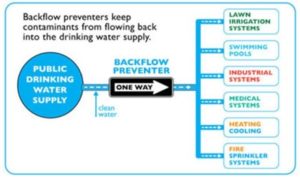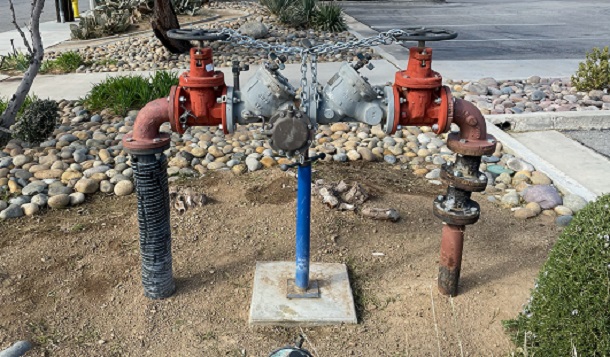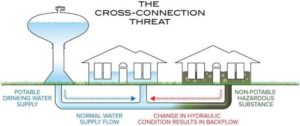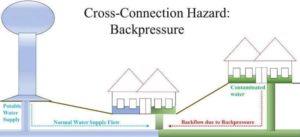Palmdale Water District is dedicated to supplying its customers with safe and healthy drinking water. The Cross-Connection Control Program (CCCP) is one way we comply with Title 17 of the California Code of Regulations.
The CCCP protects the potable water distribution system from possible contamination or pollution due to backflow. To accomplish this, Palmdale Water District requires the installation of backflow prevention assemblies in all new commercial and industrial establishments, whether or not they currently store or use harmful contaminants.
Palmdale Water District Cross-Connection Control Plan
Title 17 – California Code of Regulations
SWRCB CCCP Notice of Policy
FEE NOTICE
Starting July 1, 2021, a Cross-Connection Control annual paper processing fee of $35.00 will be added to your account for the manual processing of hard copy submittals.
To avoid this fee, please use the information below to sign up for the PWD Cross-Connection Control online program managed through Syncta. The program is using Syncta to electronically notify customers about their annual tests.
On March 2, 2021, the PWD Board of Directors approved a Resolution 21-6 amendment to Section 8.03 and Appendix D of the Cross-Connection Control Policy – Miscellaneous Fees for the handling of paper copies for customers not using the District’s online program through Syncta.
For more information or assistance, please contact 661-441-5948.
To register for access to the cross-connection online service, please use the link below and complete the form:
Cross-Connection Online Service Registration
Please allow 72 hours for a response. Currently, normal business hours are Monday – Thursday, 8AM – 5PM, by appointment only.
Once the account is created by Cross-Connection staff, you will receive an email to complete your account. Owners will be able to assign testers to complete test forms.
Use the following link to sign in to an existing account:
https://palmdale-water-district.syncta.com
Use the following link to sign in to report test results for an owner:
https://palmdale-water-district-testers.syncta.com
Any actual or potential connection or structural arrangement between a public or a consumer’s potable water system and any other source or system through which it is possible to introduce into any part of the potable system any used water, industrial fluid, gas, or substance other than the intended potable water with which the system is supplied. A few common cross-connection points in the home plumbing system would be the hose bib used in conjunction with a garden hose. With its portability, you can easily inadvertently connect the drinking water system to an untold amount of dangerous chemicals, cleaners or even the sewer system. The sprinklers used on the irrigation system can be another point, along with a utility or kitchen sink.
Identifies cross-connections through the inspection and evaluation of a consumer’s water supply to determine whether solid, liquid or gaseous pollutants or contaminants are allowed to enter the potable water system.

When a hazard to the potable water system is found, the consumer is required to install an approved backflow prevention assembly at a key location within the system to circumvent the contamination. The type and location of the backflow prevention device is dependent upon the nature of the hazard and complexity of the onsite piping. The backflow prevention assembly is approved based upon specifications developed jointly by regulatory agencies, plumbing officials and the manufacturing industry. The laboratory work of the Foundation for Cross-Connection Control at the University of Southern California and the Mechanical Testing Laboratory of the City of Los Angeles, Department of Building and Safety are essential elements of this program.
Water that is fit for consumption by humans. The United States Environmental Protection Agency (EPA) identifies biological and chemical contaminants in drinking water that occur at levels that may adversely affect public health. The EPA establishes Maximum Contaminant Levels (MCLs) permissible in drinking water, which become enforceable standards.
The Safe Drinking Water Act (SDWA) of 1974 and subsequent amendments is the main federal law designed to protect the public’s health by regulating the quality of the nation’s public drinking water supply. The SDWA authorizes the EPA to set minimal national standards for individual states to comply with. In California, it is the California Department of Public Health (CDPH) that is the lead agency to ensure that the water purveyor meets those standards, with one of the standards being the implementation of a Cross-Connection program. The initial step of Palmdale Water District’s Cross-Connection Program started in 1988 with the Board of Director’s approval of Ordinance No. 88-1.
Palmdale Water District’s goal is to provide high-quality water to our current and future customers. PWD puts forth a great deal of effort to protect the quality of that water while it is under its stewardship. It is possible that the water quality could be compromised after it has passed through the water meter and into the customer’s plumbing and when there is a cross-connection along with a backflow condition.

Backflow is the undesirable or unintended reverse flow of water in the distribution or the home plumbing system. There are two types of backflow: back siphonage and backpressure. Back siphonage can occur when there is a reduction or the creation of negative pressure via a hydraulic condition in the distribution system, which then could draw the water from the premises back into the water district’s distribution system. Back pressure would be when the pressure of the homeowner’s onsite system becomes higher than that of the distribution system. This could be caused by an onsite auxiliary booster pump or a hot water heater with a faulty temperature/pressure (TP) relief valve.

Is responsible for field surveys of industrial, commercial, residential, and medical facilities to ensure that no hazardous conditions exist between plant equipment, processed waters, plumbing fixtures and the potable water system.
The Cross-Connection and Water Pollution Control Program identifies cross-connections through the inspection and evaluation of a consumer’s water supply to determine whether solid, liquid or gaseous pollutants or contaminants are allowed to enter the potable water system. When a hazard to the potable water system is found, the consumer is required to install an approved backflow prevention assembly at a key location within the system to circumvent the contamination. The type and location of the backflow prevention device is dependent upon the nature of the hazard and complexity of the onsite piping.

Backflow prevention is important; it allows the flow of potable water to go in one direction only. There are many types of backflow preventers with different uses, installation requirements and varying degrees of backflow protection against whatever contaminant or pollutant that the drinking water may come in contact with. There are backflow preventers that are testable to confirm that they are working properly while there are others that are not.
An example of non-testable backflow protection, also the most common and the most effective, would be a simple air gap. This is the physical vertical separation between the outlet of the faucet or pipe above the flood rim of the receiving sink or vessel. This gap should be twice the diameter of the outlet pipe with a minimum of 1” if the outlet pipe is less than a ½”. Another example of a non-testable backflow preventer would be a properly installed Atmospheric Vacuum Breaker (AVB) on a residential irrigation system. The AVB should be installed a minimum of 6” (measured from the bottom of the AVB) above the finished grade and also higher than any part of the downstream piping with no-shut off or control valves located after it. At the garden hose, a Hose Bib Vacuum Breaker (HBVB) needs to be installed at the hose bib to prevent back-siphonage from happening.
Of the testable types of backflow preventers, there are those located on the service connection right after the water meter. This is known as “Meter Service Protection” and falls under Palmdale Water District’s jurisdiction. There are also testable backflow preventers that may be found internally on the customer’s plumbing. These are known as “Internal Protection” and are the responsibility of the County of Los Angeles Department of Public Health with regards to testing. Generally, testing of backflow preventers is required a minimum of once a year.
The testable type of backflow preventers that falls under PWD’s authority is on service connections belonging to commercial, multi-residential and irrigation accounts. Customers of these locations are notified of the annual requirement for backflow testing with a Field Testing & Maintenance Report Form. The customer is responsible for arranging for and hiring of personnel who hold a current “Backflow Prevention Device Tester” certification issued by Los Angeles County Public Health to conduct the testing. PWD encourages all owners and testers to sign up and utilize the District’s web-based backflow test reporting system for reporting. No fees will be accessed for using the online service.
To register for access to the online service follow this registration link and complete the form. Please allow 72 hours for a response. Currently, normal business hours are Monday – Thursday, 8 a.m. – 5 p.m., by appointment only.
Once the account is created by Cross-Connection staff, you will receive an email to complete your account. Owners will be able to assign testers to complete test forms.
For any additional information on cross-connection, backflow prevention, approved list of backflow preventers or a short ist of backflow prevention testers, you may contact the Palmdale Water District Cross-Connection Program administration.
Los Angeles County Public Health listing of testers, information, recycled water: www.lapublichealth.org
Foundation of Cross-Connection Control and Hydraulic Research – USC List of approved backflow assemblies: www.usc.edu/dept/fccchr/list.html
United States Environmental Protection Agency (EPA) Cross-Connection Manual www.epa.gov
| Cookie | Duration | Description |
|---|---|---|
| cookielawinfo-checkbox-analytics | 11 months | This cookie is set by GDPR Cookie Consent plugin. The cookie is used to store the user consent for the cookies in the category "Analytics". |
| cookielawinfo-checkbox-functional | 11 months | The cookie is set by GDPR cookie consent to record the user consent for the cookies in the category "Functional". |
| cookielawinfo-checkbox-necessary | 11 months | This cookie is set by GDPR Cookie Consent plugin. The cookies is used to store the user consent for the cookies in the category "Necessary". |
| cookielawinfo-checkbox-others | 11 months | This cookie is set by GDPR Cookie Consent plugin. The cookie is used to store the user consent for the cookies in the category "Other. |
| cookielawinfo-checkbox-performance | 11 months | This cookie is set by GDPR Cookie Consent plugin. The cookie is used to store the user consent for the cookies in the category "Performance". |
| viewed_cookie_policy | 11 months | The cookie is set by the GDPR Cookie Consent plugin and is used to store whether or not user has consented to the use of cookies. It does not store any personal data. |
To all Backflow Testers and Plumbing Companies:
Please let the PWD Cross Connection Department know if you have any questions.
The above information is from continued correspondence with Daniel Bacani, of L.A. County Public Health & Pollution Control and Sean Cleary, of IAPMO/ASSE.
As of June 17th, ABPA and ASSE have been added to the SWRCB list of accredited backflow prevention programs.
